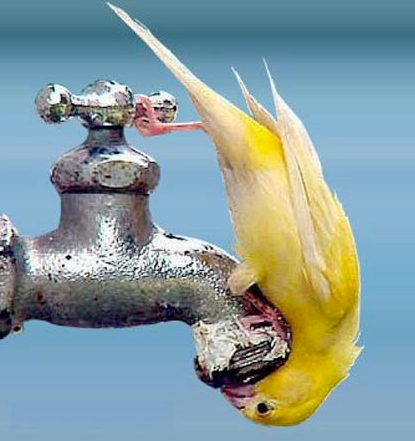( – promoted by buhdydharma )
 The World Economic Forum (WEF) issued a report warning that the world may face in less than 20 years a huge and pervasive water bankruptcy of fresh water shortages. The problem is that water is a finite resource, yet management and policies are based on the erroneous assumption that a renewable resource is inexhaustible. We generally have the same quantity of water that was available for dinosaurs. However, water sustainability is not possible unless we address issues of population growth, increased irrigation for food, energy water needs, waste, mismanagement and pollution of water supplies. Another factor is water barons, hoarders and hunters who work to control and seize our diminishing water supplies for their own financial benefit. If we don’t wake up to our water crisis, we could end up just like the bird, looking for water.
The World Economic Forum (WEF) issued a report warning that the world may face in less than 20 years a huge and pervasive water bankruptcy of fresh water shortages. The problem is that water is a finite resource, yet management and policies are based on the erroneous assumption that a renewable resource is inexhaustible. We generally have the same quantity of water that was available for dinosaurs. However, water sustainability is not possible unless we address issues of population growth, increased irrigation for food, energy water needs, waste, mismanagement and pollution of water supplies. Another factor is water barons, hoarders and hunters who work to control and seize our diminishing water supplies for their own financial benefit. If we don’t wake up to our water crisis, we could end up just like the bird, looking for water.
In California, water resources are protected by the public trust doctine, which provides that rivers, groundwater basins, and lakes are dedicated to the use of all members of the public and are not capable of private ownership. Even the State cannot claim ownership of water supplies, but rather has the obligation to regulate water resources for the public trust rather than exclusively private purposes. When a person or water agency obtains a permit from the State to divert water for any use, such as irrigation or domestic water supplies, the permittee only obtains a usufructuary interest, or the right to the use of the water. Our laws ensure that after water is used it is then returned to the watershed so that it can be reused.
The water barons, hoarders and hunters prefer formulating water policies based on privatization where water is a mere commodity rather than a human right. The World Water Council (WWC) is an international think tank that was established in 1996 and represents 350 member organizations in 70 countries. On the surface, it sounds like a good organization that is interested in a policy of sustainable water supplies. However, there are indications that sustainability means controlling our diminishing world water supplies for profit.
WWC members are not elected but include representatives from the U.S. and globally that include financial institutions, such as the World Bank; government agencies (U.S. Army Corps of Engineers, U.S. Bureau of Reclamation); water multinational companies (Suez Environnement); governments, non-governmental organizations, businesses, professional networks and research institutions.
One problem is that the WWC views the solution to global water shortages as “concerted action from governments, civil society and business to invest in water efficiency, increasing underground water storage, and allocating water in a smarter way among the users.” The WWC apparently believes the “smarter way” to allocate water is privatization so that they can line their pockets with the yellow gold from the control over the blue liquid gold. Not just privatization of water services, but also the lakes and streams in some cases.
This unelected body comprised of members from governments and the private sector is regulating water by establishing initiatives to implement its vision of a global water policy. Key players are involved at all stages of policy formulation and implementation thanks to corporate nepotism and the close links among the WWC, World Bank and private water multinationals involved in the transactions. The members and officials of the World Bank, the WWC and the International Monetary Fund (IMF) include officials from water corporations. For example, IMF advisers have conveniently included vice presidents of Suez and Vivendi, global water corporations that privatize the delivery of potable water to citizens to replace government services.
 Implementation of privatization policy is not a problem when the World Bank, a WWC member, forces privatization on poor countries. In 1/3 of the projects between 1990 and 2002, the World Bank required countries to privatize as a condition precedent to receipt of funds. In 1990, around 10% of the loans required privatization but this kept increasing until it hit 80% in 2002.
Implementation of privatization policy is not a problem when the World Bank, a WWC member, forces privatization on poor countries. In 1/3 of the projects between 1990 and 2002, the World Bank required countries to privatize as a condition precedent to receipt of funds. In 1990, around 10% of the loans required privatization but this kept increasing until it hit 80% in 2002.
In the U.S., private water suppliers may charge 33% more for water service than public government service. In 1999, by contrast, Bolivia privatized the water systems in Cochabamba after the World Bank threatened to stop water development loans if water systems were not privatized. The Bolivia privatization was supposed to increase water rates by 35%, but the reality was water bills were doubled and tripled such that many could not afford. The result was hundreds of thousands of persons were deprived of potable water service, which meant that 1 out of 10 children would die, many from illnesses related to the lack of clean drinking water. This resulted in a successful water war of citizens taking to the streets to drive out the international water privatizer.
The WWC initiatives and policies can also be implemented, for example, by executing agreements with foreign governments and agencies. Last July, the Chinese government “agreed with the World Water Council upon a strong collaboration.” If the ultimate project is funded by the World Bank and it harms environment or people, then the World Bank just claims immunity from international and national laws.
 There are also water hunters—like Nestle, Coca Cola and Pepsi — that grab water from communities. Nestle pumped groundwater so aggressively in the U.S. that the lake levels dropped, stream systems turned into mud flats and wells dried up. Moreover, Nestle does not own the water, but only has the right to the use of the water. Yet, water is shipped out from the watershed which prevents return flows to the basin. Nestle did not pay for the water, but did enjoy the millions of dollars in profits from selling bottled water.
There are also water hunters—like Nestle, Coca Cola and Pepsi — that grab water from communities. Nestle pumped groundwater so aggressively in the U.S. that the lake levels dropped, stream systems turned into mud flats and wells dried up. Moreover, Nestle does not own the water, but only has the right to the use of the water. Yet, water is shipped out from the watershed which prevents return flows to the basin. Nestle did not pay for the water, but did enjoy the millions of dollars in profits from selling bottled water.
 There is also the lying-in-wait water hoarders, like T. Boone Pickens, who is applying his successful corporate raider skills to water that he views as a commodity. Pickens bought up the land overlying the Ogallala aquifer which does not have any source of replenishment and plans to sell water to cities outside the basin with water shortages at money-making prices that could yield $165 million a year in sales to Dallas:
There is also the lying-in-wait water hoarders, like T. Boone Pickens, who is applying his successful corporate raider skills to water that he views as a commodity. Pickens bought up the land overlying the Ogallala aquifer which does not have any source of replenishment and plans to sell water to cities outside the basin with water shortages at money-making prices that could yield $165 million a year in sales to Dallas:
Pickens says Dallas would have to pay $675 per acre-foot for the water, while El Paso, separated from the Panhandle by a mountain range, would face a $1,400 per acre-foot charge. By contrast, the Southern California deal [with a private company other than Pickens] sets an initial levy of $230 per acre-foot.

Six oil giants have also “cornered the market” on Western Slope water rights for oil shale, setting the stage for water wars as water for oil shale production will preclude water for agriculture and home development.
The report details more than 200 water rights held by the companies, totaling 7.2 million acre-feet in diversions and 2 million acre-feet in water storage rights in the Colorado and White river basins.
…Many of the conditional and perfected water rights owned by energy companies date back to the 1950s and are senior to rights owned by other users, such as local water districts, ski areas and agricultural stakeholders.
When DC finally gets around to addressing our water crisis, it will be far worse.
GreenRoots is a new environmental series created by Meteor Blades and Patriot Daily for Daily Kos. This is the first time that our environmental community has had a “room of its own” for the discussion, advocacy and political activism of all environmental issues.
Please join a variety of hosts on Sunday, Tuesday, and Thursday evenings. Each Wednesday is hosted by FishOutofWater.

19 comments
Skip to comment form
Author
i’m so hot now could use some of that water!
7 day heat wave even causing back yard lizards to burrow under till it breaks.
Thanks for this (haven’t had a chance to read yet — but will soon).
There is something to be “hot” about every GD minute of the day.
“La plus ca change, la plus c’est . . . . ”
Nice to see you!
I wrote & posted this elsewhere a few years ago.
VIOLENT CONCEPTION

Throughout the geographical & geological history of this “Blue Planet” violence has been a subjective reality. As a result of avarice backed by big guns, the strong, deluded by arrogance have plundered from the perceived weak. While fueling their weapons with oil, a geological byproduct, man has ignored the “Blue” in Blue Planet. While this liquid death is being depleted the next weapons are being assembled to make water the next control medium. We may be killing for oil now, but we`ll be dying without water. The violence the future promises, will be a direct result of the rape of mother earth by it`s supposedly highest order of life form. This image is about wasting water while subjugating one to take theirs. The sweating rapist. sad
That should keep us going for a while.
Enough of this shit.
…GW bought up the land over the largest remaining fresh water aquifer in South America, and it’s probably not just to quench the thirst of his private armies. We’re finally out of drought here, though SC still draws down our reservoirs to cool their nukes, SC and GA really NEED green golf courses too. That water never comes back to the highlands.